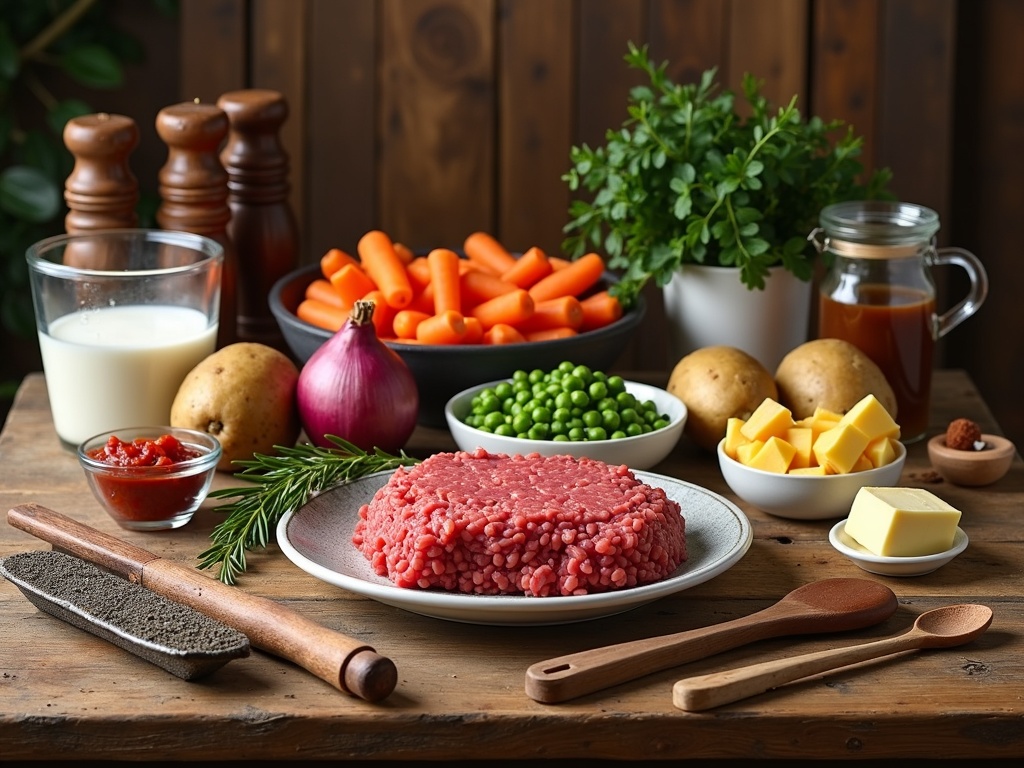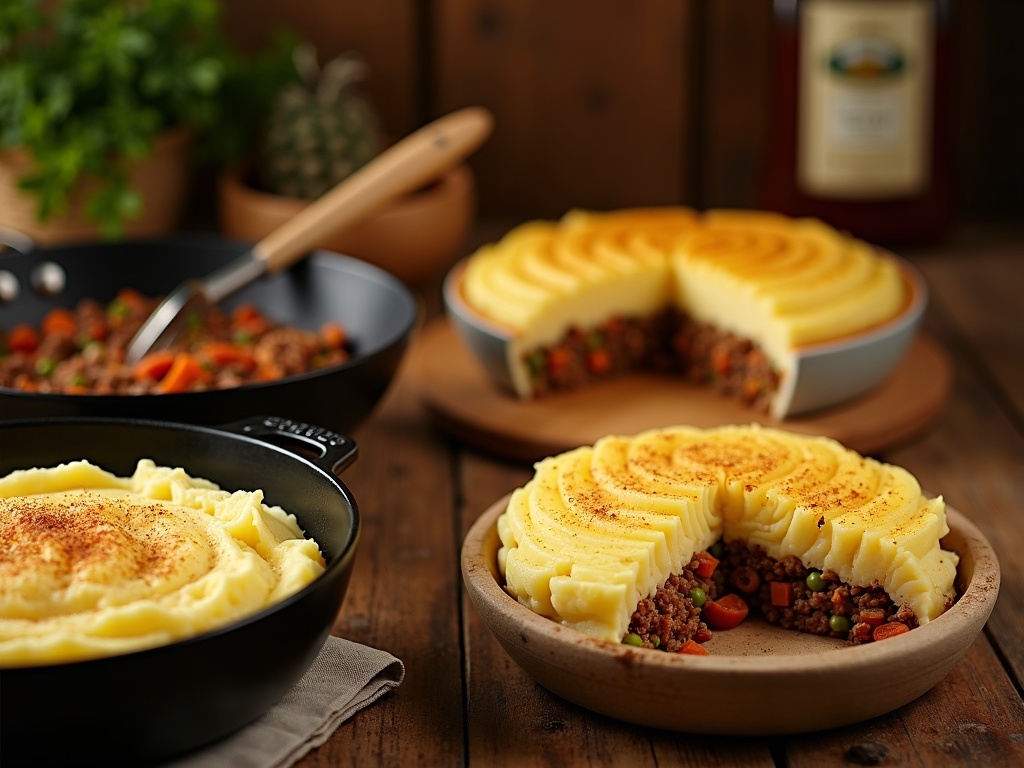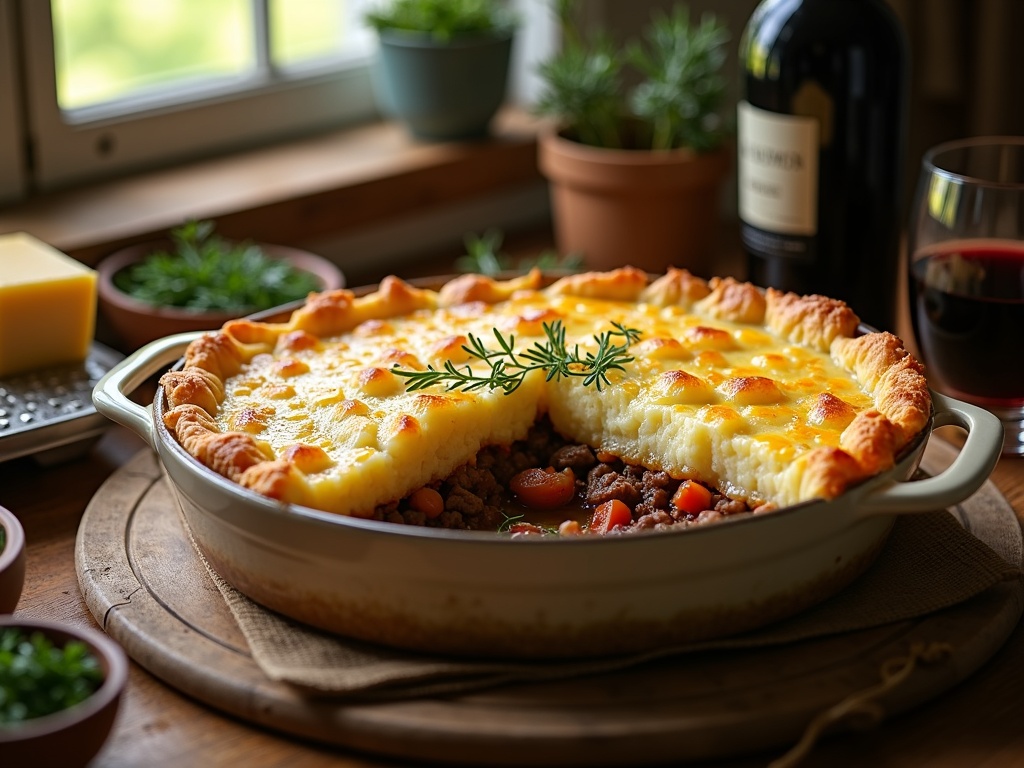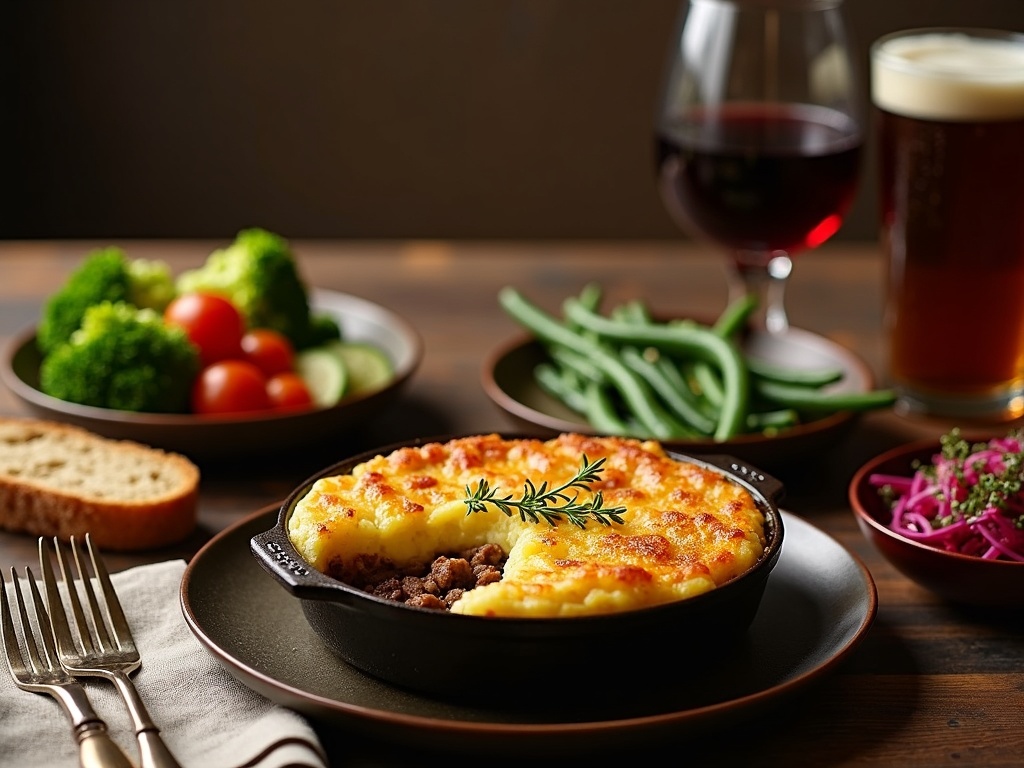Table of Contents
Cottage Pie Recipe: A Classic British Comfort Food
Cottage pie, a late 18th century creation, combines savory ground beef with creamy mashed potatoes for a filling family dinner. This British comfort food started as a smart way to use leftover meat and differs from shepherd’s pie by using beef instead of lamb.
Key Takeaways
- The dish features a rich meat filling topped with fluffy mashed potatoes, creating contrasting textures that make each bite satisfying.
- Using 85/15 ground beef, fresh vegetables, and adding depth with Worcestershire sauce or red wine enhances the flavor profile.
- Creating peaks in the potato topping before baking helps achieve the signature golden-brown, crispy crust that defines a great cottage pie.
- Common mistakes include watery filling, overworked potatoes, and skipping the crucial 15–20 minute resting period after baking.
- Cottage pie is perfect for make-ahead meals, freezing well for up to 3 months and often tasting better the next day as flavors develop.
Tips for a Perfect Cottage Pie Recipe
I find cottage pie delivers the perfect balance between comfort and flavor. The contrast between the rich, meaty base and the fluffy potato topping creates a dish that satisfies even the pickiest eaters. For the best results, I always drain excess fat after browning the meat and add a splash of beef broth to intensify the savory notes. The key lies in creating those textured peaks in the potato topping — they catch the heat and transform into crispy, golden bites that complement the succulent filling below.
What Makes the Cottage Pie Recipe So Special
Cottage pie has been warming British hearts and bellies since the late 18th century. This classic dish emerged during the Industrial Revolution when potatoes became a staple crop for the working class. It was originally created as a clever way to use leftover roasted meat, making it one of the earliest examples of economical home cooking. The name “cottage pie” referred to the modest homes of rural workers who relied on this filling meal.
Many people confuse cottage pie with shepherd’s pie, but there’s a key difference. Traditional cottage pie uses ground beef as its base, while authentic shepherd’s pie is made with lamb. The confusion is understandable since both feature savory meat filling topped with a crown of fluffy mashed potatoes. In the UK, this distinction is taken quite seriously, though in other parts of the world, the terms are often used interchangeably.
The Perfect Family Meal
I can’t think of a better dish for busy households than cottage pie. Here’s why it stands out as an exceptional family dinner option:
- One-dish convenience: Everything you need for a balanced meal in a single casserole dish
- Batch-cooking friendly: Makes excellent leftovers and can be frozen for up to three months
- Budget-friendly: Ground beef stretches beautifully when combined with vegetables and topped with potatoes
- Customizable: Easily adjusted to accommodate dietary preferences or what’s in your pantry
- Kid-approved: The familiar flavors appeal to even picky eaters
- Nutritionally balanced: Protein, vegetables, and carbohydrates all in one dish
The beauty of cottage pie lies in its simplicity and adaptability. The rich, savory flavor of beef and gravy beneath creamy mashed potatoes creates the ultimate comfort food experience. The contrasting textures—fluffy potato top with crispy edges and moist, flavorful filling—make each bite satisfying in a way few other dishes can match.
For meal preppers, the cottage pie recipe is a godsend. I often make a double batch on Sunday, serving half for dinner and portioning the rest into individual containers for quick weekday lunches. The flavors improve after a day or two as they meld together in the refrigerator.
Everything You Need For This Recipe
The key to a delicious cottage pie starts with gathering the right ingredients. I’ve put together a simple list of everything you’ll need to create this classic comfort food that combines savory ground beef filling with creamy mashed potatoes.
Key Ingredients
For the meat filling, you’ll need:
- 1 pound of ground beef – I recommend using 85/15 lean-to-fat ratio for the best flavor
- 1 medium onion, finely diced
- 2 medium carrots, peeled and diced into small cubes
- 1 cup of frozen peas
- 1 cup of beef broth (low-sodium works best)
- 2 tablespoons of tomato paste for depth and richness
- Salt, pepper, and herbs like thyme or rosemary to taste
For the potato topping, gather:
- 4 large russet potatoes (about 2–2.5 pounds total)
- 4 tablespoons of butter
- 1/4 cup of milk or cream
- Salt and pepper to taste
Optional but recommended additions include Worcestershire sauce, a clove of minced garlic, or a splash of red wine to enhance the savory gravy base. For those who enjoy a bit of kick, a pinch of red pepper flakes works wonderfully.
The beauty of cottage pie lies in its flexibility. You can easily swap out ingredients based on what you have on hand. Don’t have fresh carrots? Frozen will work just fine. The same goes for the peas. If you’re looking for more ground beef recipe options, you might find alternatives that inspire variations on this classic dish.
For the best results, I suggest letting your potatoes cool slightly before spreading them over the meat mixture. This helps create that perfect textured top that browns beautifully in the oven. Also, using room temperature butter and warm milk makes for creamier mashed potatoes.

Step-By-Step Cooking Instructions
Preparing the Potato Topping
Creating the perfect potato topping starts with choosing the right potatoes. I recommend using starchy varieties like Russets or Yukon Golds for a fluffy, creamy topping. Peel and cut the potatoes into 1-inch cubes, then place them in a large pot with cold, salted water. Bringing them to a boil from cold water ensures even cooking. Once fork-tender, drain thoroughly and return to the hot pot to evaporate excess moisture.
For ultra-creamy mashed potatoes, add warm butter and heated milk or cream rather than cold ingredients. This prevents the starches from seizing up. A splash of cream cheese or sour cream adds wonderful richness to the topping. Season with salt and pepper, and consider adding a pinch of nutmeg for subtle depth. Similar techniques work well when preparing ground beef and gravy over mashed potatoes for other comforting meals.
Cooking the Meat Filling
The heart of any cottage pie is its savory meat filling. Start by heating oil in a large skillet over medium-high heat. Add diced onions and carrots, cooking until softened. Next, add the properly cooked ground beef, breaking it apart with a wooden spoon as it browns. Once the meat has lost its pink color, drain excess fat if needed.
Add minced garlic and tomato paste, stirring for about 30 seconds until fragrant. Pour in beef broth and Worcestershire sauce, then add frozen peas, herbs like thyme and rosemary, and seasonings. Sprinkle in flour or cornstarch to thicken the mixture, stirring constantly to prevent lumps. Let the filling simmer until it reaches a thick, gravy-like consistency.
Assembling and Baking
The layering process is simple but crucial for a perfect cottage pie:
- Transfer the meat mixture to a 9×13 baking dish, spreading it evenly.
- Carefully spoon the mashed potatoes over the filling, starting from the edges and working toward the center. This helps seal in the meat mixture.
- For a decorative touch, create peaks and ridges in the potato topping using a fork or spatula. These will brown beautifully in the oven.
Bake in a preheated 400°F oven for 25-30 minutes until the potato topping turns golden brown and crispy. If needed, you can switch to the broiler for the last few minutes to achieve that perfect golden crust, similar to how I finish my French onion meatloaf.
Allow the cottage pie to rest for at least 10-15 minutes before serving. This resting time lets the flavors meld and helps the pie set, making it easier to serve neat portions. The result is a hearty, comforting dish that’s perfect for family dinners.

Make Your Cottage Pie Extra Special
I’ve found that elevating a classic cottage pie from good to extraordinary requires attention to a few key details. With some simple tweaks, you can transform this humble dish into something truly memorable for family dinners or entertaining guests.
Enhancing Flavor Profiles
Using fresh herbs makes a remarkable difference in your cottage pie. Fresh thyme and rosemary infuse the meat mixture with aromatic flavors that dried herbs simply can’t match. I like to add them in two stages – some during cooking to infuse the base, and a sprinkle of chopped fresh herbs just before assembling for brightness.
Adding wine to the meat mixture creates incredible depth of flavor. A splash of red wine (about 1/2 cup) does wonders when added after browning the meat and vegetables. Let it reduce for 2–3 minutes before adding your stock and other liquids. The alcohol cooks off, leaving behind concentrated flavors that enhance the savory qualities of the beef.
Perfecting Your Presentation
Creating perfect mashed potatoes for the topping requires a few specific techniques:
- Use starchy potatoes like Russets or Yukon Golds for the fluffiest texture
- Add warm (not cold) butter and milk to keep potatoes smooth
- Season generously with salt and pepper while mashing
- Incorporate a small amount of sour cream for tangy richness
- Beat in an egg yolk for extra richness and golden color when baked
Getting that golden-brown top is the hallmark of a truly special cottage pie. I achieve this by:
- Brushing the potato surface with melted butter
- Creating texture with a fork (make little peaks)
- Placing it under a hot broiler for the final 3–5 minutes of cooking
- For extra indulgence, sprinkle some grated cheese over your mashed potatoes before broiling
The contrast between the crispy golden top and the rich savory ground beef mixture underneath creates the perfect bite. These small adjustments require minimal extra effort but dramatically improve both the presentation and taste of your cottage pie, making it a standout dish that family and guests will request again and again.

Common Mistakes To Watch Out For
When making a cottage pie, small missteps can significantly impact the final result. I’ve noticed several common issues that can turn this classic comfort dish from extraordinary to ordinary. Let’s dive into these pitfalls so you can avoid them in your next homemade cottage pie.
Preventing Kitchen Disasters
Watery filling can ruin an otherwise perfect cottage pie. This typically happens when the meat mixture hasn’t been simmered long enough to reduce excess liquid. To fix this, I cook my filling until most of the liquid has evaporated, leaving just enough sauce to keep the meat moist without making it soupy. If you’re short on time, a quick fix is adding a tablespoon of flour or cornstarch mixed with cold water to thicken the sauce. This is especially important when using ground beef with gravy, as proper consistency makes all the difference.
Overworking the potatoes is another common mistake. When mashed potatoes become gummy and sticky, they’ve been overworked. This happens because excessive stirring or processing releases too much starch. For perfect mashed potato topping, I gently mash the potatoes by hand or with a ricer, then fold in warm butter and milk. Using the gentlest touch possible creates that fluffy, light texture that makes a cottage pie topping so delicious.
The baking temperature can make or break your cottage pie. Too hot, and the potato topping dries out before the filling is heated through. Too cool, and you’ll miss that beautiful golden crust. I’ve found that starting at 400°F (200°C) for about 20 minutes to brown the top, then reducing to 350°F (175°C) for another 10-15 minutes works perfectly. This approach gives you that appealing golden crust while ensuring the filling is hot and bubbling. The principle is similar to what I use when making French onion meatloaf – getting the right balance of high heat for color and moderate heat for thorough cooking.
Skipping the resting period is a mistake that leads to a messy serving. Cutting into a cottage pie straight from the oven results in filling that spills everywhere. Just like with most ground beef recipes, patience pays off. I always let my cottage pie rest for 15-20 minutes after taking it out of the oven. This resting period allows the filling to set and makes serving much neater. It also prevents burned mouths from overly hot filling!
Here are some additional tips to ensure cottage pie success:
- Properly prepare your meat by cooking ground beef until well-browned before adding other ingredients
- Use a fork to create texture on the potato topping for more crispy edges
- Add a sprinkle of cheese in the last 5 minutes of baking for extra flavor
- Taste and adjust seasoning before assembling – the potato layer can dilute flavors
- Use a deep dish rather than a shallow one to prevent overflow during baking
By avoiding these common mistakes, you’ll create a cottage pie with perfect texture, flavor, and presentation. The contrast between the creamy potato topping and savory meat filling is what makes this dish such a beloved comfort food classic.
Smart Tips For The Best Results
Getting the most out of your homemade ground beef dish means knowing how to prepare, store, and serve it efficiently. I’ve gathered some practical advice to help you enjoy cottage pie at its best while saving time and reducing waste.
Make-Ahead and Storage Solutions
Cottage pie shines as a perfect make-ahead meal. I recommend preparing it up to 2 days before serving – simply assemble the pie, cover tightly with foil, and refrigerate. This actually improves the flavor as ingredients meld together over time.
For freezing options, you can freeze cottage pie either before or after baking:
- Unbaked: Assemble completely, cover with plastic wrap and foil, then freeze for up to 3 months
- Baked: Cool completely, portion if desired, wrap thoroughly and freeze for up to 2 months
- Individual portions: Perfect for quick meals – freeze in oven-safe containers for grab-and-heat convenience
When it’s time to reheat, you have several approaches depending on your situation:
- From refrigerated: Bake at 350°F for 25–30 minutes until hot throughout
- From frozen (unbaked): Remove plastic wrap, keep foil on, bake at 350°F for 1 hour, then remove foil and bake 15–20 minutes more
- From frozen (baked): Thaw overnight in refrigerator then follow refrigerated instructions, or bake from frozen at 350°F for 1–1.5 hours
For the best texture when reheating, I find adding a small splash of beef broth helps keep the ground beef and gravy layer moist while preventing the potatoes from drying out.
Portion sizing depends on your guests and meal planning needs. For family dinners, a standard 9×13 dish serves 6–8 people comfortably. If cooking for fewer people, consider:
- Using smaller baking dishes (8×8) for 4 servings
- Making individual ramekins for 1–2 servings each
- Dividing a full recipe between two smaller dishes – bake one now, freeze one for later
When transforming leftovers, consider adding a fresh element like a simple side salad or complementary rice dish to create a new meal experience. The hearty flavors of cottage pie often taste even better the second day as the seasonings continue to develop.
Perfect Pairings And Serving Suggestions
When serving cottage pie, I find that complementary sides and beverages elevate this humble dish into a complete dining experience. The rich, savory flavors of cottage pie call for thoughtfully selected accompaniments that balance rather than compete with its hearty profile.
Complementary Side Dishes
I’ve discovered several side dishes that pair beautifully with cottage pie, creating a balanced meal that’s both satisfying and visually appealing:
- Green vegetables: Steamed broccoli, roasted Brussels sprouts, or butter-glazed green beans provide a fresh contrast to the richness of the pie. Their vibrant color also makes the plate more appealing.
- Simple salads: A crisp garden salad with a light vinaigrette cuts through the density of the dish. Try mixed greens with cherry tomatoes and cucumber for a refreshing counterpoint.
- Crusty bread: A slice of warm sourdough or a crusty baguette is perfect for soaking up any remaining gravy on your plate.
- Pickled vegetables: Quick-pickled red cabbage or beetroot adds a tangy element that contrasts nicely with the savory beef and potato combination.
- Peas and carrots: If not already included in your cottage pie filling, these classic vegetables make an excellent side dish.
For wine enthusiasts, cottage pie offers several pairing possibilities. A medium-bodied red wine like Merlot or Pinot Noir complements the savory meat filling without overwhelming it. These wines have enough structure to stand up to the rich flavors while maintaining balance. For white wine drinkers, an oaked Chardonnay provides enough body to match the dish. Beer lovers might enjoy a brown ale or porter, whose malty notes enhance the pie’s savory aspects.
The presentation of cottage pie can transform it from casual comfort food to an impressive dinner option. I like adding finishing touches just before serving. A light sprinkle of fresh herbs like thyme or parsley adds color and freshness. For texture contrast, consider a scatter of lightly fried shallots or caramelized onions across the top. Some home cooks even add a light dusting of smoked paprika for color and a subtle flavor boost.
Cottage pie often tastes even better the next day, making it ideal for planned leftovers. To store properly, let the pie cool completely before covering with plastic wrap or transferring to airtight containers. Refrigerated leftovers stay good for 3–4 days. For longer storage, cottage pie freezes exceptionally well – individual portions work best for quick weeknight meals. When reheating, I cover the dish with foil for the first part of heating to prevent the potato top from drying out, then remove it for the last few minutes to restore some crispness.
For family meals, I sometimes create a ground beef bar with the pie as the centerpiece, surrounded by small bowls of additional toppings like grated cheese, chopped green onions, or hot sauce for everyone to customize their portion. This interactive approach makes dinner more engaging, especially for younger diners.
For special occasions, consider serving cottage pie in individual ramekins or mini cast iron skillets for an elevated presentation. This not only looks impressive but allows the edges of the potato topping to crisp beautifully. Paired with a glass of well-chosen wine and thoughtful sides, this humble ground beef dish transforms into a sophisticated meal worthy of company.


